
Receipt
What is a Receipt?
A receipt refers written proof that a commodity or service of value has been exchanged between two parties. In other words, receipts serve as proof of financial transaction. One of the main reasons that receipt is important is the aspect of ownership. Receipts issued within a time frame also serve as a warranty card. Receipts are not a part of just the buying and selling transactions but also exists in business dealings and stock Market transactions. Receipts are also used in taxations.

The Internal Revenue Service (IRS) requires that the following types of receipts be generated and retained by small businesses:
- Gross Receipts
- Raw Material Purchase Receipts
- Credit Card statements
- Credit Card Receipts
- Invoices
- Cash Register Tape Receipts
- Invoices
Ancient Egypt and Receipts
Ancient Egypt upheld the practice of retaining receipts which is still in trend today. Farmers and traders would keep up with receipts in order to avoid exploitation in taxation. During those times, papyrus would be used to record the exchange. With the coming of the printing press and today’s modern technology, receipts are printed on paper with the business’ logo on it.
Talk to our investment specialist
Receipts and IRS Requirements
The Internal Revenue Service, in 1997, accepted digital and scanned receipts as valid documents for tax purposes. Since then, digital receipts have become the necessity of the day. According to a procedure, as mentioned under IRS, digital receipts should be accurate, preserved, stored, retrieved and reproduced. An owner of a business should be able to supply a copy to the IRS. However, remember that not all receipts are valid for documentation with the IRS. The receipt should have the amount of transaction, date, place and expense type.
Note that digital records can’t be scratched away or torn, but can be lost if the hard drive or digital storage system fails. In order to keep it safe, make sure to store it on cloud or Google drive so that it can be accessed anywhere easily. In the case of paper receipts, you can store it digitally by scanning the document.
All efforts have been made to ensure the information provided here is accurate. However, no guarantees are made regarding correctness of data. Please verify with scheme information document before making any investment.






